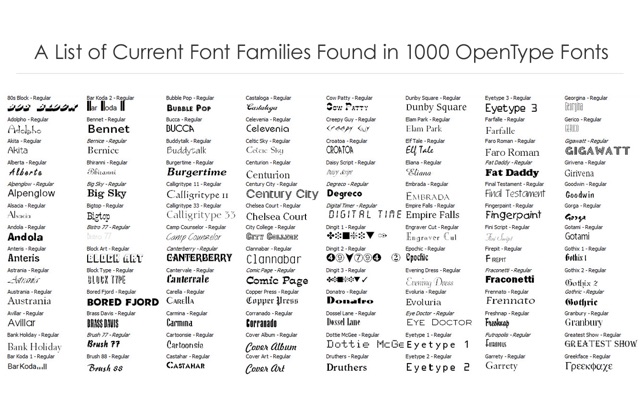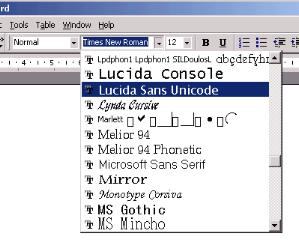How To Use Downloaded Fonts In Word For Mac
Do NOT follow the advice given by mediadebb. Unless, that is, you don't mind deleting every font Office installed for your use. You can have as many subfolders in either the main Library's Fonts folder, or the Fonts folder in your user account as you want. There is one problem with that Microsoft folder, but it doesn't have anything to do with its existence. The problem is that Office installs old versions of newer fonts already installed by OS X. Those create font conflicts between those fonts.
Adobe Font installation guide for windows 7, XP, Vista & mac. You can use the Windows Fonts control panel to install or remove fonts of all these formats,.
What you do need to remove are the old conflicting fonts. In the main /Library/Fonts/Microsoft/ folder, remove these older legacy TrueType fonts.
Note that they do not have a file extension such as.ttf. Andale Mono Arial Black Arial Narrow Arial Rounded Bold Comic Sans MS Georgia Impact Tahoma Trebuchet MS.
Basically, your system isn't working right if added fonts don't show up in all apps. As explained above, did you activate these fonts after Word (or any Office app) was running? If so, then no, newly activated fonts won't appear until you shut down the Office app and relaunch it. Fonts not appearing in all apps (even though Font Book says they're active) is a very common fault with Font Book.
Follow these basic font resetting steps: Close Font Book if it's open, and any other apps you may have running. From the desktop, hold down the Shift key and choose Go Library from the menu.
Open the Preferences folder. Put the following two items in the trash: com.apple.FontRegistry.user.plist com.apple.FontBook.plist Keep all other apps closed. From an administrator account, open the Terminal app and enter the following command. You can also copy/paste it from here into the Terminal window: sudo atsutil databases -remove Terminal will then ask for your admin password. As you type, it will not show anything, so be sure to enter it correctly. This command removes all font cache files. Both for the system and the current logged in user account.
After running the command, close Terminal and immediately restart your Mac. When the system boots back up, do not launch Font Book. Manually place the fonts you want to see in Office 2011 in the Fonts folder of your user account. You can also place them in the root /Library/Fonts/ folder. It doesn't matter where within either one.
Now launch your Office apps and test. Assuming nothing is wrong with the OS or the fonts themselves, the fonts should be available.
Thank you, That is clear and seems like it ought to work, but it didn't. I tried it again after also deleting some Microsoft.plist files that seemed font related. I also moved the Font folders out of my user Library and disk Library (leaving only the required fonts in the System Library). That reduced the fonts showing in Word by a few, but Word continued to show some fonts (well, at least one, I didn't check further) that are not in that folder. Word was still finding Century Gothic. After I moved the Fonts folder back to the disk Library, Word was the way it was before, showing some of the fonts in that folder, but not all.
I suppose I can try reinstalling OSX next? I appreciate your help. Before spending the time reinstalling the OS, create a new test user account and login to it. Try Word from the new account. If fonts behave as they should there, then the problem is somewhere in your normal account. If the same thing happens, then it's a system wide issue. That could be the OS needing a reinstall, Office needing to be reinstalled, or both.
Another quick thought. Is Office 2011 up to date? From within any Office app, click Help Check for Updates. If there are any, apply them and see if it helps. Word was still finding Century Gothic.
Century Gothic was installed by Office 2011. When you move any fonts out of the root /Library/Fonts/ folder, the OS (though not always) may still consider them open. Even if you put them in the trash. You have to restart to release the fonts from use. After restarting, nothing from the /Library/Fonts/ folder should appear in Word. Wow: Even reinstalling OSX has not helped. The fonts are still not showing in Word.
To recap: I'm using OS 10.11.4 and Office 2011 for Mac. The same problem exists in another account on this Mac. The problem does not exist in non-Office programs. I've used Fontbook.
I've deleted duplicate fonts manually from the Fonts folders. I've used FontNuke to delete font caches. I've deleted the Normal.dotm template, and, from one or both Library/Preferences folders:. file com.apple.FontBook.plist.

com.apple.FontRegistry.user.plist. com.microsoft.word.plist. com.microsoft.office.plist. I've reinstalled the operating system. Is there anything left to try, other than reinstalling Word? (I can't find the key to reinstall, don't want to buy Office for Mac 2016 because it's said to be crap, neither do I want to pay even more money ⚠ for the same old version again!).
Is it just this specific third party font you're trying to use that won't appear in Word, or does it vary (some system fonts won't appear, either). I was helping someone else some months back with a font set that wouldn't appear in Word, and only Word 2011. They sent me the fonts to look over. There was nothing technically wrong with them but I rebuilt the internal names and saved them back out as OpenType fonts.
Just rewriting a font can often fixes issues with it. The new fonts worked in every single app as they were supposed to - except Word 2011. Of the four type faces (regular, italic, bold, bold italic), Word would not for any reason show the bold italic font.
Is this a free font I can download from the same site you got it from? I'd like to look it over and see what's going on. Or, you could email it to retoucher at jklstudios dot com. I have no issues with Office 2016. Yes, the initial perpetual release had some ugly bugs/behavior, but the 15.15 updates cleaned up virtually everything (it's up to 15.20 now). Apple Footer.
Mac Stable Release Notes and History; Mac Beta Release Notes and History; Mac. Logos Blog 28 Aug 2009 Logos for Mac 1.2.1 compatible with OS X 10.6. Mac only release history prior to 4.2a => Mac Release Notes and History. 7.18 and Newer releases need TLS 1.2 for online connection as of 7 Nov 2018 7.14. Logos bible software releases version 1.2 for mac.
How To Use Downloaded Fonts In Word For Mac Free

Where To Put Downloaded Fonts
This site contains user submitted content, comments and opinions and is for informational purposes only. Apple may provide or recommend responses as a possible solution based on the information provided; every potential issue may involve several factors not detailed in the conversations captured in an electronic forum and Apple can therefore provide no guarantee as to the efficacy of any proposed solutions on the community forums. Apple disclaims any and all liability for the acts, omissions and conduct of any third parties in connection with or related to your use of the site.
All postings and use of the content on this site are subject to the.
Office 2019 Office 2019 for Mac Office 2016 Word 2007 PowerPoint 2007 Office 2016 for Mac Office 2010 Office 2013 Most applications (such as Microsoft Word, Excel, and PowerPoint) include fonts that are automatically installed when you install the software. For example, applications that are created especially for document design projects, such as Microsoft Publisher, often come with quite a few extra fonts that you can use with any other program on your computer.
However, sometimes you may want to install custom fonts that you've created, purchased or downloaded from somewhere else. In this article we'll talk about how to install those fonts so you can use them in Microsoft Office. Note: To embed fonts in a Microsoft Office Word document or PowerPoint presentation, see. Locate custom fonts on the Web In addition to acquiring and using fonts installed with other applications, you can download fonts from the Internet. Some fonts on the Internet are sold commercially, some are distributed as shareware, and some are free. The site provides links to other font foundries (the companies or individuals outside of Microsoft who create and distribute fonts) where you can find additional fonts.
After you find a font that you would like to use with an Office application, you can download it and install it through the operating system that you are currently using on your computer. Because fonts work with the operating system, they are not downloaded to Office directly. You should go through the system's Fonts folder in Windows Control Panel and the font will work with Office automatically.
On the Mac you use the Font Book to add the font and then copy it to the Windows Office Compatible folder. Many third parties outside of Microsoft package their fonts in.zip files to reduce file size and to make downloading faster. If you have downloaded a font that is saved in.zip format double-click the zip file to open it. Install a custom font you have downloaded Once you've downloaded the font you want to install you need to install it in the operating system.
Once the font is properly installed in the operating system Microsoft Office will be able to see and use it. For detailed instructions select the operating system you're using from the drop-down box below. Note: If you're using Office 2011 for Mac, you may need to drag and drop the font to the Windows Office Compatible collection in the Font Book to make it available to Microsoft Office. Sharing files that contain non-standard fonts When you install a custom font, each font will work only with the computer you've installed it on.
Custom fonts that you've installed on your computer might not display the same way on a different computer. Text that is formatted in a font that is not installed on a computer will display in Times New Roman or the default font.

Therefore, if you plan to share Microsoft Office Word, PowerPoint, or Excel files with other people, you'll want to know which fonts are native to the version of Office that the recipient is using. If it isn't native, you may have to embed or distribute the font along with the Word file, PowerPoint presentation, or Excel spreadsheet.
For more information about this see. See also. Do you have ideas for how we can improve Microsoft Office?